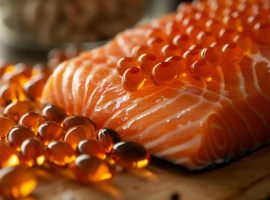Understanding Omega-3 Fatty Acids and Skin Health
Omega-3 fatty acids, particularly EPA (eicosapentaenoic acid) and DHA (docosahexaenoic acid), are pivotal for maintaining skin health. These essential fats contribute to the skin’s lipid barrier, crucial for retaining hydration and maintaining elasticity. By integrating into cell membranes, they provide structural integrity that supports the skin’s ability to hold water, resulting in a more supple and youthful appearance.
The Anti-Inflammatory Impact of Omega-3s
The role of omega-3s extends to mitigating inflammation, a common culprit behind skin conditions such as acne. By modulating the body’s inflammatory response, these fatty acids can help reduce the occurrence and severity of acne breakouts. Their anti-inflammatory properties also aid in soothing conditions like eczema and psoriasis, where skin inflammation is a significant symptom.
Protection Against UV Damage
Exposure to UV radiation can accelerate skin ageing and damage. Omega-3 fatty acids from fish have been shown to offer a degree of protection against such UV-induced photodamage. They achieve this by combating oxidative stress and supporting the skin’s natural response to sun exposure, potentially reducing the risk of premature ageing and skin cancer.
Utilisation of Omega-3s in Skin Maintenance
Your body utilises omega-3s to fortify skin health by incorporating them into the skin’s lipid layers, enhancing barrier function and resilience. Regular consumption of omega-3-rich fish supports the maintenance of this barrier, ensuring the skin remains hydrated, plump, and less prone to irritation and dryness.
The Nutritional Profile of Skin-Friendly Fish

Certain fish stand out as nutritional powerhouses for skin health, rich in essential vitamins and minerals. Salmon, mackerel, tuna, and sardines are particularly beneficial due to their high levels of omega-3 fatty acids, which are crucial for maintaining skin hydration and elasticity. These fatty fish also provide a wealth of antioxidants, including astaxanthin in salmon, which combats oxidative stress and may reduce the signs of ageing.
Antioxidants and Skin Health
Antioxidants in fish, such as vitamin E and selenium, play a pivotal role in protecting the skin from environmental damage. They help to neutralise free radicals, which can lead to premature ageing and skin disorders. The consumption of these nutrient-rich fish supports the body’s antioxidative defence system, promoting overall skin health.
Superiority of Fatty Fish
Fatty fish are considered superior for skin care due to their high concentrations of omega-3 fatty acids, particularly EPA and DHA. These nutrients are not synthesised by the body and must be obtained through diet. They are known for their anti-inflammatory properties, which can alleviate skin conditions such as acne and psoriasis.
Protein’s Role in Skin Repair
The protein found in these fish is essential for skin repair and collagen production. Collagen is the main structural protein in the skin, responsible for its strength and elasticity. Regular consumption of these protein-rich fish can aid in maintaining a firm and youthful skin appearance, as well as accelerate the healing process of damaged skin.
Dietary Recommendations for Optimal Skin Health

To harness the skin health benefits of fish, it is recommended to include fish in your diet regularly. The FDA suggests consuming 8-12 ounces of a variety of seafood per week, which equates to two to three servings. This frequency supports skin health by providing a steady intake of essential nutrients without overexposure to potential contaminants.
FDA Guidelines on Fish Consumption
The FDA’s guidelines are designed to minimise exposure to mercury while maximising the health benefits of fish. They recommend including a variety of seafood in your diet and emphasise the importance of consuming fish rich in omega-3 fatty acids, such as salmon, mackerel, sardines, and tuna.
Tailoring Fish Selection to Skin Conditions
For individuals with specific skin conditions, certain fish may offer additional benefits. For example, fish high in omega-3 fatty acids, like salmon, can be particularly beneficial for inflammatory skin conditions such as eczema or psoriasis due to their anti-inflammatory properties.
Balancing Nutrient Intake and Contaminant Risks
To balance the benefits of fish consumption with concerns about contaminants like mercury, it is crucial to choose fish known for lower mercury levels. The FDA provides a list of such fish, and organisations like the Marine Stewardship Council (MSC) offer certifications to guide consumers toward sustainable and safer choices.
Preparing Fish to Maximise Skin Health Benefits

Optimal Cooking Methods for Nutrient Preservation
To preserve the skin-enhancing nutrients in fish, gentle cooking methods such as steaming, baking, or poaching are recommended. These methods prevent the destruction of omega-3 fatty acids and maintain the integrity of vitamins and minerals essential for skin health. Grilling or broiling should be done cautiously to avoid charring, which can diminish nutrient content and introduce harmful compounds.
Ensuring Safe Cooking Practices
Safety in cooking fish is paramount to retain its nutritional value and avoid foodborne illnesses. Fish should be cooked to an internal temperature of 145F, as measured by a food thermometer, to ensure it is safe for consumption. Additionally, proper storage and handling prior to cooking are crucial to prevent contamination.
Enhancing Bioavailability of Nutrients
Certain preparations can enhance the bioavailability of nutrients beneficial for the skin. Incorporating healthy fats like olive oil can increase the absorption of fat-soluble vitamins. Adding citrus or other vitamin C-rich foods can aid in the absorption of iron from fish, further supporting skin health.
Simple Recipes for Daily Skin Health
For daily meals, simple recipes that combine skin-friendly fish with a variety of colourful vegetables and whole grains can provide a balanced intake of nutrients. Recipes such as salmon with a lemon-herb dressing or sardines on whole-grain toast offer both convenience and a boost to skin health.
Wild-Caught Versus Farmed Fish: Implications for Skin Health

When considering the impact on skin health, the source of fishwhether wild-caught or farmedcan influence the nutrient profile. Wild-caught fish often have a more varied diet, which can lead to a higher content of omega-3 fatty acids, crucial for skin hydration and elasticity. Conversely, farmed fish may have different levels of nutrients due to controlled feed that can be enriched with specific vitamins and minerals.
Nutrient Content Variations
The nutrient content between wild and farmed fish can vary significantly. Wild fish typically consume a natural diet, leading to a potentially higher accumulation of antioxidants like astaxanthin, particularly in species like salmon. Farmed fish, however, might be fed with fortified feeds that can increase certain nutrient levels, such as vitamin D and omega-3s, to meet health standards.
Sustainability and Fish Quality
Sustainability practices are integral to the quality of fish and, subsequently, the health benefits they provide. Sustainable fishing practices help ensure the long-term viability of fish populations and ecosystems, which can affect the purity and safety of the fish you consume.
Choosing the Right Fish for Skin Health
When selecting between wild and farmed fish, consumers should consider the environmental impact, the presence of contaminants, and the nutritional benefits. Certifications such as the Marine Stewardship Council (MSC) can guide consumers toward fish that are not only better for the environment but also potentially higher in skin-beneficial nutrients.
Plant-Based Omega-3 Sources Versus Fish: A Comparison

When it comes to skin health, omega-3 fatty acids are vital, and while fish is a well-known source, plant-based alternatives also offer omega-3s. Flaxseeds, chia seeds, and walnuts contain alpha-linolenic acid (ALA), a type of omega-3 that the body can partially convert to EPA and DHAthe forms readily available in fish.
Structural Differences in Omega-3s
The omega-3 fatty acids from plant sources are structurally different from those found in fish. ALA from plants requires conversion to EPA and DHA, which occurs at a low rate in humans. This means that the direct benefits of EPA and DHA from fish are more immediately available to the body than those from plant-based ALA.
Absorption and Conversion Efficiency
The body’s efficiency in absorbing plant-based omega-3s and converting them to the active forms used for skin health is less than the direct absorption of fish-derived omega-3s. However, for individuals who do not consume fish, consuming a higher quantity of plant-based omega-3s can help to meet their nutritional needs.
Effective Plant-Based Alternatives
For those seeking plant-based omega-3 sources, algae-based supplements are an effective alternative. They provide EPA and DHA directly, similar to fish, and can support skin health for individuals following vegetarian or vegan diets. Including a variety of ALA-rich foods in the diet can also contribute to overall omega-3 intake.
Evaluating the Efficacy of Fish Oil Supplements for Skin Health

Fish oil supplements are often considered as an alternative to whole fish for those seeking the skin health benefits of omega-3 fatty acids. While supplements can provide a concentrated dose of omega-3s, the efficacy of these supplements for skin conditions is a subject of ongoing research.
Research Insights on Omega-3 Supplements
Studies have shown mixed results regarding the impact of fish oil supplements on skin health. Some research indicates potential benefits in reducing skin inflammation and improving hydration, while other studies suggest that the effects may be less significant than those obtained from consuming whole fish.
Omega-3 Concentrations: Supplements vs. Whole Fish
The concentrations of omega-3s in fish oil supplements can vary widely. High-quality supplements may offer similar amounts of EPA and DHA as found in servings of fatty fish like salmon or mackerel. However, the bioavailability and absorption rates may differ, with whole fish providing additional nutrients that can aid in skin health.
Considerations for Supplement Selection
When choosing a fish oil supplement for skin health, consider the following factors:
- Purity: Look for supplements that have been purified to remove contaminants like mercury.
- Concentration: Check the levels of EPA and DHA to ensure you’re getting an effective dose.
- Form: Triglyceride forms of omega-3s may be more easily absorbed than ethyl esters.
- Certifications: Third-party testing and certifications can provide assurance of the supplement’s quality and safety.
It is essential to consult with a healthcare provider before starting any supplement regimen, especially if you have underlying health conditions or are taking other medications.
Addressing Skin Conditions Through Fish Consumption

Incorporating omega-3-rich fish into your diet can be beneficial for managing common skin conditions such as eczema and acne. The anti-inflammatory properties of omega-3 fatty acids, particularly EPA and DHA, can help reduce the skin’s inflammatory response, which is a key factor in these conditions.
Omega-3s and Skin Inflammation
Omega-3 fatty acids found in fish like salmon, mackerel, and sardines have been shown to alleviate symptoms of skin conditions by:
- Reducing the production of inflammatory eicosanoids and cytokines.
- Modulating the inflammatory process in the skin.
- Improving the skin’s barrier function, which can be compromised in conditions like eczema.
Limitations of Diet in Skin Health Management
While diet plays a crucial role in skin health, it is not a standalone solution for skin conditions. Factors such as genetics, environmental triggers, and overall health also significantly influence skin conditions. A balanced diet can support skin health but may need to be complemented with other treatments prescribed by healthcare professionals.
Fish Selection for Specific Skin Issues
Certain types of fish may offer more targeted benefits for specific skin issues:
- Salmon is rich in both omega-3 fatty acids and astaxanthin, a potent antioxidant that can benefit ageing or sun-damaged skin.
- Sardines and mackerel are high in EPA and DHA, which can be particularly helpful for inflammatory skin conditions.
Contribution of Fish to Skin Condition Management
The anti-inflammatory effects of omega-3 fatty acids contribute to the management of skin conditions by:
- Reducing redness and swelling associated with acne and eczema.
- Helping to manage the symptoms of psoriasis, which is characterised by skin cell overproduction and inflammation.
Visual Aids for Understanding Skin Benefits of Fish

Visuals such as infographics can significantly enhance comprehension of the skin benefits of fish. They provide a quick, at-a-glance understanding of complex information, such as the nutrient profiles of different fish and their specific benefits for skin health.
Role of Preparation Tips
Preparation tips serve as practical guidance, transforming theoretical knowledge into actionable steps. They empower you to apply the health information directly to meal planning and cooking, ensuring that the skin health benefits of fish are fully realised.
Structuring Content for Engagement
The article’s format should be structured to facilitate easy reading and engagement. Breaking down the content into digestible sections with clear subheadings and bullet points allows for better navigation and retention of information.
Effective Visual Content Types
The most effective visual content for illustrating the health benefits of fish includes:
- Charts: Displaying the omega-3 content in different types of fish.
- Diagrams: Showing how omega-3 fatty acids affect skin layers.
- Photos: Providing visual cues on how to properly prepare and cook fish to preserve its nutrients.
- Step-by-step guides: Offering a visual walkthrough of cooking techniques that enhance the skin health benefits of fish.
Insights from Nutritionists and Dermatologists on Fish and Skin Health

Nutritionists and dermatologists often emphasise the skin health benefits of incorporating fish into your diet. They point out that fish rich in omega-3 fatty acids, such as salmon and mackerel, can significantly improve skin hydration, reduce inflammation, and may even protect against UV-induced skin damage.
Personal Improvements in Skin Health from Fish Consumption
Many individuals report noticeable improvements in their skin’s appearance and health after regularly including omega-3-rich fish in their meals. Benefits include enhanced skin moisture, reduced acne breakouts, and a more even skin tone.
Challenges in Dietary Improvements for Skin Health
Adopting a diet for better skin health can present challenges, such as accessibility to quality fish, dietary preferences, and the need for consistent consumption to see benefits. Some individuals may also need to consider potential allergens and dietary restrictions.
Relating to Personal Experiences
Readers can relate to personal stories shared within the article by recognising common skin concerns and seeing the tangible benefits that others have experienced. These anecdotes can serve as motivation and validation for making dietary changes to improve skin health.
Sustainable Seafood Consumption and Skin Health

Sustainable seafood is not only a stewardship of marine life but also ensures the long-term health benefits of fish consumption. By choosing sustainably sourced fish, you’re supporting fisheries and aquaculture that maintain healthy fish populations and ecosystems, which directly impacts the quality and safety of the seafood you consume.
Identifying Sustainably Sourced Fish
To identify sustainably sourced fish, consumers should look for:
- Ecolabels: Certifications like the Marine Stewardship Council (MSC) or the Aquaculture Stewardship Council (ASC) on packaging.
- Traceability: Information about the fish’s origin, including where and how it was caught or farmed.
- Transparency: Brands that provide detailed information about their sustainability practices.
Certifications for Skin-Health-Focused Seafood
When selecting fish for skin health, certifications to consider include:
- MSC Certified: Indicates the fishery has met rigorous standards for sustainability.
- ASC Certified: Shows the farm operates under responsible aquaculture practices.
“Frozen Fish Direct” and Sustainability
Frozen Fish Direct” ensures the sustainability of its offerings by:
- Sourcing from fisheries and farms with recognised sustainability certifications.
- Implementing a traceability system to track the journey of the fish from catch to delivery.
- Offering a selection of seafood that adheres to the seasons, supporting natural fish populations and cycles.
Key Takeaways for a Skin-Healthy Fish Diet

Incorporating fish into your diet can significantly enhance skin health due to the rich array of nutrients they provide. Omega-3 fatty acids, particularly EPA and DHA, are instrumental in maintaining skin hydration and reducing inflammation. Vitamins D and E, along with minerals like zinc and selenium, offer additional skin protection and repair benefits.
Starting Dietary Changes for Enhanced Skin Health
To begin improving skin health through diet, consider these steps:
- Introduce fish such as salmon, mackerel, tuna, and sardines into meals twice weekly.
- Opt for cooking methods that preserve the integrity of nutrients, such as baking or steaming.
- Seek out sustainably sourced fish to ensure the highest quality of nutrients and environmental responsibility.
Resources for Further Learning
For those looking to delve deeper into the benefits of fish for skin health, resources are available through:
- Nutritional Dermatology Research: Scholarly articles and studies that explore the connection between diet and skin health.
- Dietary Guidelines: Official recommendations from organisations like the FDA on safe fish consumption.
“Frozen Fish Direct” and Quality Fish Provision
“Frozen Fish Direct” aids consumers in accessing quality fish for a skin-healthy lifestyle by:
- Offering a wide variety of frozen fish, preserved at peak freshness to retain nutrient content.
- Ensuring sustainability and traceability from catch to delivery, aligning with environmental and health standards.









